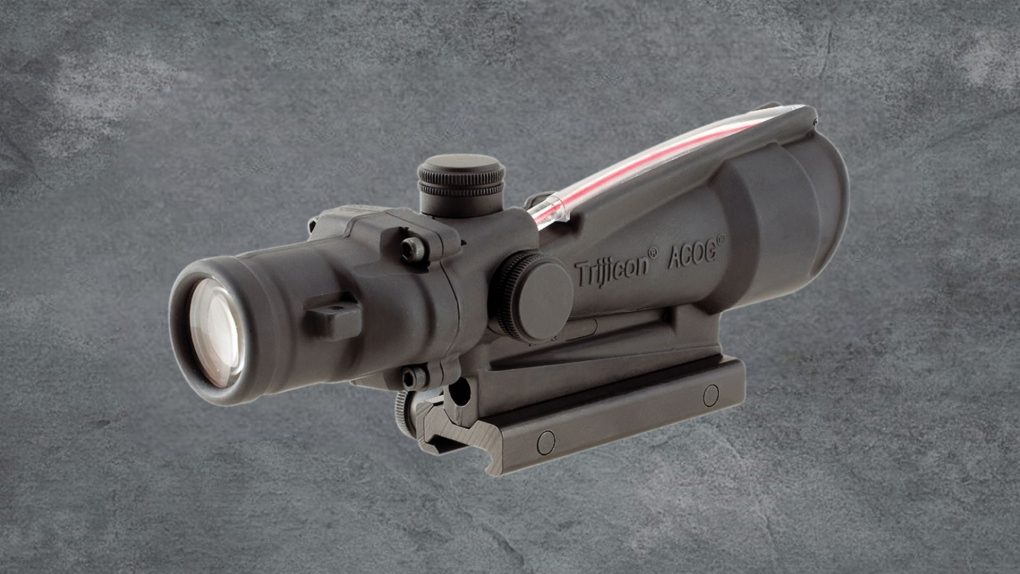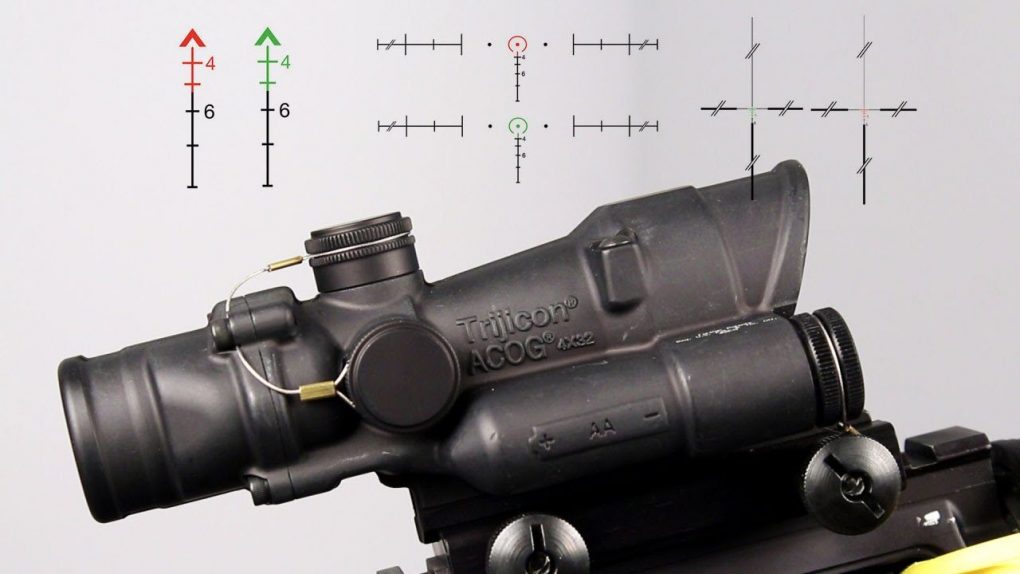You’re peering through your Trijicon ACOG, and it’s time to choose the right reticle. Whether you’re aiming for precision with a classic crosshair or quick target acquisition with a chevron, each design impacts your shot.
You’ll learn how doughnut variations offer a unique focus, and why BDC reticles are essential for ranging. Dive into a detailed, technical comparison of Trijicon’s reticles to find out which suits your tactical needs best.
Let’s dissect their differences and applications.
→ Find out more in other articles by Steele Industries:
–https://steeleindustries.com/spot-vs-blem-night-vision-terms-you-need-to-know/
–https://steeleindustries.com/troubleshooting-your-night-vision-device/
–https://steeleindustries.com/night-vision-technology-a-comprehensive-overview/
–https://steeleindustries.com/does-bright-light-hurt-night-vision-devices/
– For more reading, visit our blog!
Contact:
-Call us at (800) 674-7302
-E-mail: sales@steeleindinc.com
–Facebook/ steeleindustriesinc
–Instagram/steeleindustriesinc
Key Takeaways
- Trijicon ACOG scopes revolutionized precision aiming for soldiers in the military market in 1987.
- Different reticle types available in Trijicon ACOG scopes serve distinct purposes, such as precision aiming, rapid target acquisition, and quick focusing.
- Measurement markings on the reticles, including hash marks, dots, or chevrons, are essential for accurate range estimation and bullet drop compensation.
- Understanding the subtleties in measurement markings and analyzing them against target size and distance enables precise engagements, but it requires practice and understanding of external ballistics.
History of Trijicon ACOG
You’ll discover the Trijicon Advanced Combat Optical Gunsight (ACOG) was first introduced to the military market in 1987, revolutionizing precision aiming for soldiers.
This rugged, compact telescopic sight with fixed magnification was designed to enhance target identification and increase hit probability under a variety of tactical scenarios.
Its introduction marked a significant evolution from the iron sights commonly used at the time, offering superior accuracy through an illuminated reticle powered by a passive system—combining fiber optics and tritium.
This innovation provided a distinct advantage in low-light conditions without reliance on batteries.
Engineers at Trijicon focused on durability, crafting the ACOG to withstand extreme conditions and handling, which quickly established its reputation for reliability in combat situations.
Understanding Reticle Fundamentals
You must recognize the distinct reticle types available in Trijicon ACOG scopes, as each presents unique characteristics for various shooting conditions.
The pattern’s purpose is critical; it dictates precision and speed, influencing your engagement strategy with targets.
Comprehending the subtleties in measurement markings is essential for accurate range estimation and bullet drop compensation.
Reticle Types
Reticle variety in Trijicon ACOG scopes ensures you’re equipped with a targeting solution tailored to your specific shooting needs. These reticles are designed to enhance precision, speed, and versatility in various shooting scenarios. Delve into the technical aspects of each type to understand how they can optimize your performance.
| Reticle Type | Functionality |
| Crosshair | Precision aiming with fine intersection points |
| Chevron | Rapid target acquisition with an inverted ‘V’ indicator |
| Triangle | Quick focus with a bold aiming point |
| Horseshoe-Dot | Encircles target for rapid engagement |
| Bullet Drop Compensator (BDC) | Calibrated markings for distance estimation |
Each reticle pattern offers specific benefits, whether it’s the simplicity of a crosshair or the distance-targeting prowess of a BDC. Analyze your requirements to select a reticle that aligns with your tactical objectives.
Pattern Purpose
Each type of Trijicon ACOG reticle serves a distinct purpose, enhancing your shooting accuracy and speed in specific conditions.
For instance, the Chevron reticle is designed for rapid target acquisition at varying distances, its tip providing a precise aiming point for long-range shots.
The Bullet Drop Compensator (BDC) feature embedded within certain reticles allows you to quickly adjust for ballistic trajectory over several predefined distances. This is critical when engaging targets at unknown ranges.
Crosshair reticles offer a traditional sight picture, preferred by shooters who value pinpoint precision and are accustomed to classic sighting methods.
Circle-dot patterns facilitate quick focusing on close-quarter targets, with the outer circle drawing your eye to the center dot.
Each pattern’s intricacies cater to diverse operational demands and shooting styles.
Measurement Markings Interpretation
In understanding the fundamentals of Trijicon ACOG reticles, it’s crucial to learn how to interpret the measurement markings that are integral for accurate range estimation and bullet drop compensation. Each hash mark, dot, or chevron within the reticle’s design corresponds to specific angular measurements, typically in milliradians (mrad) or minutes of angle (MOA). By mastering these subtensions, you’ll precisely gauge distances and adjust for ballistic variables.
| Subtension | mrad Value | MOA Equivalent |
| Fine Dot | 0.2 mrad | 0.68 MOA |
| Small Hash | 0.5 mrad | 1.72 MOA |
| Large Hash | 1.0 mrad | 3.44 MOA |
| Chevron Tip | 1.5 mrad | 5.16 MOA |
| BDC Line | 2.0 mrad | 6.87 MOA |
Analyzing these values against target size and distance enables precise engagements. It’s a technical skill that demands practice and understanding of external ballistics.
The Classic Crosshair Reticle
You’ll recognize the classic crosshair reticle by its straightforward design, featuring intersecting lines that create a clear aiming point for precise targeting. The elegance of this reticle lies in its simplicity, which facilitates quick target acquisition without the clutter of more complex designs.
Here’s why it’s a solid choice for precision shooting:
- Unobstructed View: The minimalistic pattern ensures a clear visual field.
- Precision: Fine lines offer exact aim for small targets or long distances.
- Customization: Shooters can choose from various line thicknesses to suit their preferences.
- Reliability: With fewer elements, there’s less potential for visual distraction or confusion under stress.
Considering these factors, the classic crosshair reticle remains a preferred option for those valuing precision and simplicity.
Chevron Reticle Breakdown
Moving from the classic crosshair, let’s delve into the chevron reticle, which offers a unique aiming point shaped like an inverted ‘V’. The tip of the chevron provides a precise point of aim, allowing for enhanced accuracy at longer distances.
Unlike a dot or crosshair, the chevron doesn’t obscure the target; its open design maintains excellent situational awareness.
You’ll find that bullet drop compensation (BDC) is integrated within the chevron’s structure, facilitating quick holdover adjustments for various ranges. Analyze the stadia lines below the chevron—they’re calibrated for estimating target distances, a critical feature when engaging at variable ranges.
Doughnut Reticle Variations
As you examine the various doughnut reticles available on Trijicon ACOGs, you’ll notice that target acquisition speed is a critical factor influenced by the reticle’s design. The balance between clutter and clarity within your sight picture can significantly affect your aiming efficiency, especially under rapid engagement scenarios.
Analyze how the thickness and openness of the doughnut reticle impact your field of view and target tracking ability.
Target Acquisition Speed
In terms of target acquisition speed, the doughnut reticle variant of the Trijicon ACOG allows for swift and intuitive engagement with your target. The design streamlines the process of aligning the reticle with the intended point of impact.
Here’s why the doughnut reticle accelerates target acquisition:
- Circle Cues: The circular shape naturally draws the eye to the center, reducing the time to focus on the target.
- Peripheral Visibility: The open center maintains peripheral vision, enabling quicker reaction to moving targets.
- Contrast Enhancement: The thick outer ring stands out against varied backdrops, ensuring rapid sight alignment.
- Instinctive Use: The simplicity of the reticle design minimizes cognitive load, allowing for instantaneous and reflexive shooting actions.
Clutter Versus Clarity
While the doughnut reticle enhances target acquisition, you’ll find its variations balance clutter and clarity to suit different shooting scenarios.
The standard doughnut design offers a clear point of aim with minimal obstruction, providing rapid alignment without overwhelming your sight picture.
However, modifications like segmented circles or additional hash marks cater to precision demands, where determining holdover or windage adjustments quickly becomes crucial.
You’ll notice that thinner circle lines reduce perceived clutter, facilitating a cleaner sight picture for longer-range precision.
Conversely, thicker lines improve visibility against complex backgrounds, essential for quick, close-quarters engagements.
Analyzing these variations demands attention to detail, as each alteration affects both the speed of engagement and the potential for precise shot placement.
BDC and Ranging Reticles
Trijicon’s ACOG scopes offer you advanced BDC and ranging reticles designed to improve your long-distance accuracy and speed up target acquisition. These reticles employ a Bullet Drop Compensator (BDC) feature that helps you adjust for projectile trajectory over various distances without manual adjustment of the scope’s elevation settings.
Analytically, the reticles incorporate:
- Pre-calibrated markings for specific calibers and bullet weights.
- Horizontal stadia lines for windage corrections.
- Incremental range finding ladders for rapid distance estimation.
- Chevron or horseshoe shapes for instant target focus.
These elements are engineered to afford you a systematic approach to shooting at different ranges, with the reticle’s design minimizing the need for complex calculations, allowing for quicker and more intuitive shooting adjustments.
Comparing Reticle Performance
You’ll notice distinct differences when comparing the performance of Trijicon ACOG reticles, each tailored to optimize accuracy and speed in varied shooting conditions.
For instance, the Chevron reticle offers an exceptionally clean sight picture and an aiming point that’s precise for distances up to 300 meters. Its design significantly reduces target obscuration, allowing for rapid target acquisition in close-quarters scenarios.
Conversely, the Crosshair reticle provides a more traditional sight picture, favored for its familiarity and precision at extended ranges.
Analyzing the Horseshoe-Dot reticle, you’ll find it combines the strengths of both, offering quick target engagement at close ranges while still maintaining the ability to engage targets at distance through its finer aiming points.
Each design caters to specific operational needs, balancing visibility, and marksmanship.

Frequently Asked Questions
Can Trijicon ACOG Reticles Be Customized for Personal Preferences or Specific Applications?
You can customize Trijicon ACOG reticles for personal preferences and specific applications, tailoring them to your needs with various reticle patterns, illumination options, and ballistic compensations to enhance your shooting accuracy and performance.
How Do Trijicon ACOG Reticles Perform Under Extremely Low Light Conditions or at Night?
You’ll find Trijicon ACOG reticles perform well in low light due to their tritium-illuminated design, providing clear aiming without external light sources, but they’re not optimal for pitch-black environments without any ambient light.
Are There Any Notable Differences in the Durability and Longevity of the Various ACOG Reticle Types?
You’ll notice that while all ACOG reticles are robust, certain types may offer enhanced resistance to recoil and environmental stress, potentially affecting their longevity when compared to others in rigorous or combat situations.
How Do Colorblind Shooters Adapt to the Different Reticle Patterns Available in Trijicon Acogs?
You’d adapt to reticle patterns by selecting high-contrast options, potentially customizing brightness, and using shape differentiation rather than relying solely on color cues, ensuring effective target acquisition despite color vision deficiencies.
Can Trijicon ACOG Reticles Be Easily Swapped or Replaced by the User, or Does It Require Factory Servicing?
You can’t easily swap Trijicon ACOG reticles yourself; it requires factory servicing due to the complex, sealed design. Attempting it could void your warranty or damage the optic’s precise alignment and functionality.
Conclusion
In conclusion, you’ve seen how Trijicon ACOG reticles cater to diverse needs. The classic crosshair offers precision, while the chevron ensures quick target acquisition. Doughnut reticles provide an excellent middle ground, balancing speed and accuracy.
BDC and ranging reticles are indispensable for long-distance marksmanship, enhancing your tactical advantage. Your choice hinges on mission specifics and personal preference, with each reticle’s performance tailored to optimize your optical prowess in varied combat scenarios.
Choose wisely to gain the tactical edge.


